Fabrizio Sceberras Testaferrata | |
|---|---|
| Cardinal Bishop of Senigallia | |
 Cardinal Sceberras Testaferrata | |
| Church | Roman Catholic |
| Diocese | Roman Catholic Diocese of Senigallia |
| Installed | 6 April 1818 |
| Term ended | 3 August 1843 |
| Predecessor | Annibale Francesco Clemente Melchiore Girolamo Nicola della Genga |
| Successor | Antonio Maria Cagiano de Azevedo |
| Other post | Cardinal-Priest of S. Pudenziana |
| Previous posts | Apostolic Nuncio to Switzerland (1803-1815) Secretary of the Congregation of Bishops and Regulars (1815-1818) |
| Orders | |
| Ordination | 1802 |
| Consecration | 21 December 1802 |
| Created cardinal | 1818 by Pope Pius VII |
| Rank | Cardinal |
| Personal details | |
| Born | 1 April 1757 |
| Died | 3 August 1843 (aged 86) |
| Buried | Senigallia Cathedral |
| Nationality | Maltese |
| Parents | Pasquale Sceberras Testaferrata Lucrezia Dorell |
Fabrizio Sceberras Testaferrata (1 April 1757 - 3 August 1843) was a native of Malta and a bishop and cardinal of the Catholic Church. He was Bishop of Senigallia from 1818 until his death in 1843.